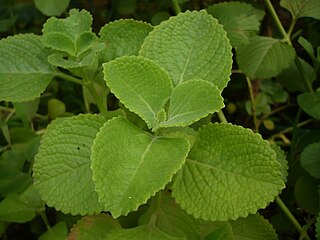Kashubian or Cassubian is a West Slavic language belonging to the Lechitic subgroup.

An inflorescence, in a flowering plant, is a group or cluster of flowers arranged on a stem that is composed of a main branch or a system of branches. An inflorescence is categorized on the basis of the arrangement of flowers on a main axis (peduncle) and by the timing of its flowering.

Coleus amboinicus, synonym Plectranthus amboinicus, is a semi-succulent perennial plant in the family Lamiaceae with a pungent oregano-like flavor and odor. Coleus amboinicus is considered to be native to parts of Africa, the Arabian Peninsula, and India, although it is widely cultivated and naturalized elsewhere in the tropics where it is used as a spice and ornamental plant. Common names in English include Indian borage, country borage, French thyme, Indian mint, Mexican mint, Cuban oregano, broad leaf thyme, soup mint, Spanish thyme. The species epithet, amboinicus refers to Ambon Island, in Indonesia, where it was apparently encountered and described by João de Loureiro (1717–1791).
A school counselor is a certified/licensed professional that provides academic, career, college readiness, and social-emotional support for all students. There are school counselor positions within each level of schooling. By developing and following a school counseling program, school counselors are able to provide students of all ages with the appropriate support and guidance needed for overall success.
SHA-2 is a set of cryptographic hash functions designed by the United States National Security Agency (NSA) and first published in 2001. They are built using the Merkle–Damgård construction, from a one-way compression function itself built using the Davies–Meyer structure from a specialized block cipher.

The Toyota Land Cruiser Prado is a full-size four-wheel drive vehicle in the Land Cruiser range produced by the Japanese automaker Toyota as a "light-duty" variation in the range.

The Mazda CX-5 is a compact crossover SUV produced by Mazda since 2012. A successor to both the Tribute and the slightly larger CX-7, it is Mazda's first model to feature the "Kodo" design language and the first model to be fully developed with a range of technologies branded as Skyactiv, including a rigid, lightweight platform combined with a series of engines and transmissions to reduce emissions and fuel consumption.

Cyme or Cumae was an Aeolian city in Aeolis close to the kingdom of Lydia. It was called Phriconian, perhaps from the mountain Phricion in Aeolis, near which the Aeolians had been settled before their migration to Asia.

Cynoglossum amabile, the Chinese hound's tongue or Chinese forget-me-not, is a species of flowering plant in the family Boraginaceae, native to Asia. A hardy annual growing to 50 cm (20 in), it has hairy leaves and cymes of sky-blue flowers in late summer. This plant, closely related to the common forget-me-not of temperate gardens, is also grown as an ornamental. In cultivation in the UK it has gained the Royal Horticultural Society's Award of Garden Merit..

Lyclene reticulata is a species of lichen moths of the family Erebidae, subfamily Arctiinae. It is found in Queensland, Australia, as well as on Ambon, Seram, Timor, Batchian, Aru, Tobriand, the Louisiade Archipelago and the Dampier Archipelago,

Ziziphus oenopolia, commonly known as the jackal jujube, small-fruited jujube or wild jujube, is a flowering plant with a broad distribution through tropical and subtropical Asia and Australasia. In India, it is mostly found in the deciduous forests of the southern part of the country.
Cyme citronopuncta is a moth of the subfamily Arctiinae. It is found in New Guinea.

Cyme pyraula is a moth of the family Erebidae first described by Edward Meyrick in 1886. It is found in the Australian state of Queensland and on New Guinea.

Cyme sexualis is a moth of the subfamily Arctiinae first described by Felder in 1864. It is found on Ambon, Sulawesi, the Dampier Archipelago, and in New Guinea.
Cyme basitesselata is a moth of the subfamily Arctiinae.
Cissus anisophylla is a plant species known from lowland rainforests of Panama, Colombia, Brazil, Peru, Costa Rica, Ecuador, and the Mexican state of Chiapas.

Cyme quadrilineata is a species of butterfly in the moth family Erebidae, found in Australian, near northeastern and northern coast.











